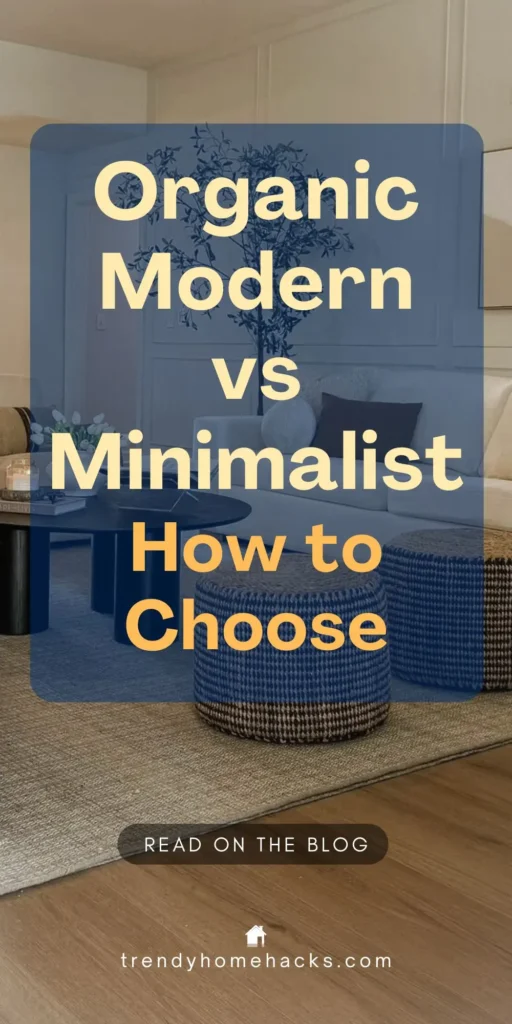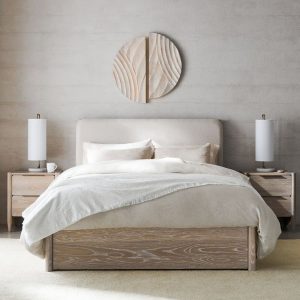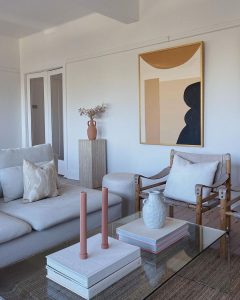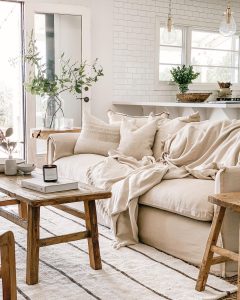There’s a quiet kind of beauty in simplicity. Lately, you might’ve found yourself pulled toward two different styles that keep popping up in your feed—Organic Modern vs Minimalist. They both feel calm. Both feel clean. But one has the warmth of linen and wood, the other the clarity of wide-open space.
If you’ve ever stood in your living room, wondering whether to add another pillow or take one away, you’re not alone. Choosing between these two looks can feel a little like choosing between a cabin and a gallery. Both are beautiful. Both can feel like home. But which one speaks to the way you live?
This guide isn’t about rules or what’s trending next. It’s about tuning in—figuring out what feels right when you walk through your front door. Whether you’re decorating a first apartment or refreshing a family home, we’ll help you understand each style’s heart—and bring more peace and personality into your space.
Organic Modern vs Minimalist Design: What Defines Each Style?
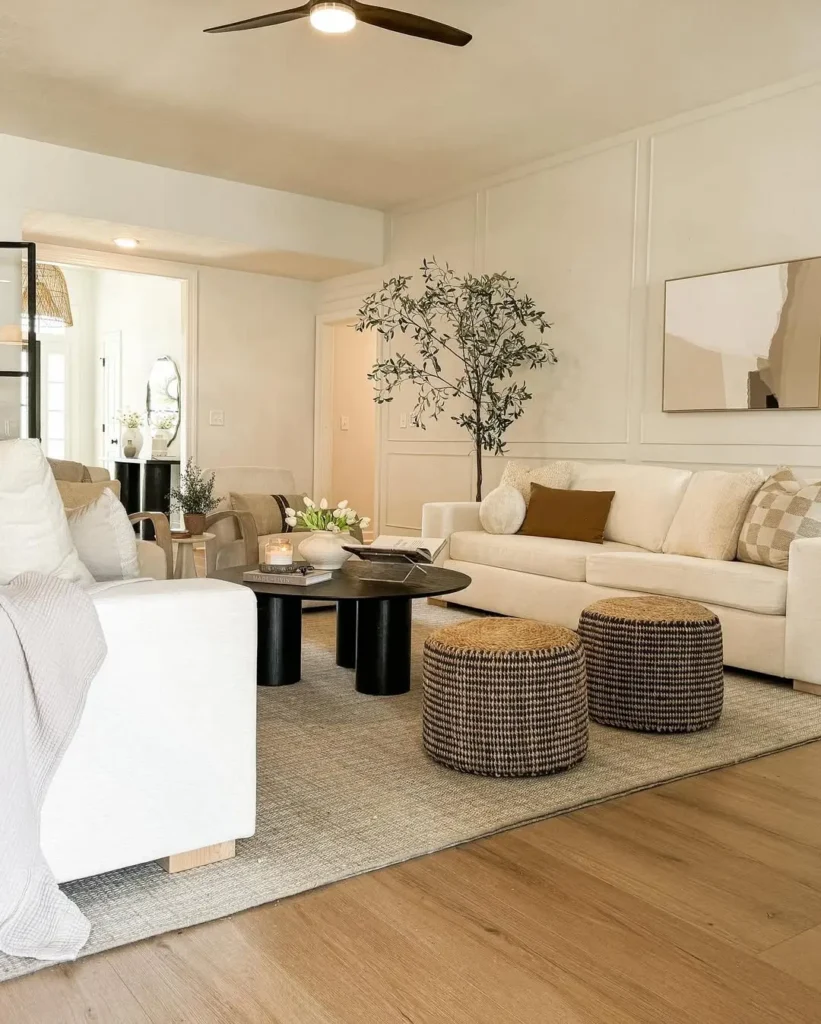
Both styles begin with simplicity—but that’s where their paths gently part. One leans into the natural world, the other into structure and stillness. Understanding what sets them apart is the first step in figuring out which one truly feels like you.
Organic Modern is rooted in nature’s textures. It’s the warmth of a wool throw over a curved chair, an oak table with handmade ceramics, sunlight dancing on stone walls. This style blends clean lines with the imperfect beauty of natural materials. It’s calm, but not cold. Intentional, but never sterile. Spaces feel lived-in, layered, and warm.
If you feel drawn to design that brings in soft edges, warm woods, and textural balance, you’ll appreciate how natural elements shape an Organic Modern home. A space feels most grounded when its design follows the quiet rhythms of the natural world.
Minimalist design, on the other hand, is about stripping things back to the essentials. Think smooth surfaces, open floor plans, and a palette pared down to black, white, and soft neutrals. Every object has a purpose. Negative space is celebrated. There’s a quiet elegance to it—a way of letting the space itself do the talking.
Where Organic Modern finds peace in nature, Minimalism finds it in clarity. And knowing which kind of peace your home needs—that’s what makes all the difference.
Room-by-Room Guide: Which Style Works Best Where
Let’s walk through each space and explore how Organic Modern and Minimalist styles shape the way your home looks. More importantly, how they support the rhythm of your everyday life.
Living Room
An Organic Modern living room feels like an invitation to stay awhile. It’s layered in texture—linen cushions, wood beams, soft wool rugs—and it brings in materials that age well and feel even better with time. You’ll often see rounded edges, open shelves, and furniture that feels sculptural without being showy.
For cozy, earthy ideas that balance warmth and clean lines, take a look at how to achieve an Organic Modern living room aesthetic.
In a Minimalist living room, the focus shifts to space and form. You’ll notice fewer pieces of furniture—each one chosen with purpose. Less visual noise means more room to breathe—making the whole space feel instantly calmer. Colors tend to be muted and consistent, with a preference for solid surfaces and clean silhouettes.
For pared-down layouts that still feel inviting, see these tips for creating a Minimalist living room.
Bedroom
An Organic Modern bedroom leans into softness. Think curved headboards, woven pendant lights, and natural materials like oak, linen, and clay. It’s restful without feeling overly polished.
If that sounds like your kind of retreat, you’ll find more inspiration in this guide to the Organic Modern bedroom look.
Minimalist bedrooms, by contrast, often rely on symmetry and simplicity. You might see floating nightstands, low-profile beds, and white walls that reflect light. The absence of clutter makes the room feel more restful.
For thoughtful ways to simplify your bedroom without losing comfort, explore these minimalist bedroom decor tips.
Dining Room
In an Organic Modern dining room, the table is the anchor. It’s often made of raw or reclaimed wood, paired with mixed textures—linen runners, matte ceramics, maybe even a branch centerpiece. It feels grounded and welcoming.
For styling ideas that add warmth and simplicity to your meals, see how to create the perfect Organic Modern dining room.
Minimalist dining rooms keep the table clean and the surroundings uncluttered. Shapes stay simple, finishes go matte or gloss, and the palette sticks to just a few tones.
If you’re looking for essentials that make a quiet statement, check out these minimalist dining room ideas.
Kitchen
The kitchen is where style and function have to work hand in hand. In an Organic Modern kitchen, you’ll see open shelving with natural wood, handmade tile backsplashes, and hardware in soft, brushed finishes. Materials like stone, ceramic, and light oak create a cozy, lived-in feeling—like a space that invites you to cook slowly and linger longer.
For a deeper look at this balance of warmth and utility, explore how to design a fresh and simple Organic Modern kitchen.
Minimalist kitchens focus on clean lines, tucked-away storage, and finishes that feel sleek and modern. Cabinetry is often flat-panel, appliances are integrated, and surfaces are kept clear. It’s a space designed to support efficiency and calm at once.
If you’re drawn to a more pared-back approach, here’s how to create a minimalist kitchen that’s both functional and beautiful.
Bathroom
A bathroom can go either way, depending on how you want it to feel. Organic Modern turns it into a personal retreat—think natural stone, textured towels, and light that shifts softly throughout the day.
For ideas that help you bring this sense of calm into your space, look at how to design an Organic Modern bathroom from scratch.
Entryway
First impressions matter. If you love a welcoming moment at the door—maybe a woven bench, soft rug, or antique console—Organic Modern makes it feel like home from the first step.
For a cozy entrance that doesn’t overdo it, see how to blend minimalism with warmth in your Organic Modern entryway.
Patio
The lines blur a bit when you step outside. Organic Modern patios feel like garden extensions—casual, textured, and built for lounging. A Minimalist patio keeps things tidy, with just enough to enjoy the view without distraction.
If you’re curating your outdoor space, see how to design an inviting Organic Modern patio and how to choose the right furniture for that space.
A Home That Flows Together
Designing with consistency doesn’t mean everything has to match. It means each room feels connected to the next.
If your home is open-concept, Minimalist design can create visual clarity and breathing space across shared areas.
Organic Modern, with its layered warmth, helps each room feel grounded without losing flow.
Let your home evolve naturally from room to room by repeating quiet elements such as tone, texture, or light.
Texture & Color: Where Organic Modern and Minimalist Truly Diverge
If there’s one place where Organic Modern and Minimalist styles part ways most clearly, it’s in how they feel—literally. Materials and color tell the deeper story of each approach.
Organic Modern leans into touch. It’s layered and tactile—raw woods, soft stone, handwoven linen, and unfinished ceramics. The palette feels rooted: sandy taupes, muted greens, and warm whites that shift with the light. It’s not loud, but it lives and breathes in every surface.
To explore how texture brings warmth into a space, look at how to include earthy textures in Organic Modern design. When the finishes are imperfect and natural, a space starts to feel like home.
Minimalism, by contrast, finds its strength in restraint. Surfaces are smooth and consistent—think glass, lacquer, or lightly grained wood. Color stays quiet: white, black, cool neutrals, and the occasional soft accent. The result is polished, even serene.
To create this sense of calm with color, see how to craft a calming minimalist color palette. It shows how clarity and cohesion can transform even the simplest room.
One invites you to run your hands over the grain. The other invites you to pause and take a breath. And in both, the beauty comes from choosing with intention.
Which Style Reflects You Best? A Personality & Lifestyle Quiz
Sometimes, the best way to choose a design style is to look inward. The way you live—how you spend your mornings, what calms you down, what inspires you—can say a lot about which aesthetic will feel right in your home. It’s not a test. It’s just a gentle way to see your space differently.
Do you love collecting meaningful objects, like ceramics from a favorite trip or a well-worn book passed down through your family? Do you reach for natural textures—linen sheets, wool throws, handwoven baskets—without even thinking about it? If your home feels most like you when it’s warm and layered, Organic Modern might be your match.
Or maybe you feel your best when the counters are clear and there’s room to breathe. You like quiet mornings, soft light, and spaces that don’t ask much of you. If clean surfaces and calm color palettes bring you peace, then Minimalism could be what you’re craving.
You might even find yourself somewhere in the middle. That’s perfectly okay. What matters most is that your space reflects your rhythms—what comforts you, what fuels you, and what lets you exhale at the end of the day.
The Beauty of Blending: Can You Mix Organic Modern and Minimalist?
Sometimes the best design choice isn’t picking sides—it’s finding a rhythm that draws from both. If you’re pulled toward the earthy calm of Organic Modern but also love the spacious clarity of Minimalism, you’re not alone. These styles overlap more than you might think—and when blended thoughtfully, they create a look that feels personal and balanced.
Start with what they share: a love of simplicity, intentional living, and homes that breathe. From there, it’s all about contrast. You might pair a sleek, low-profile sofa with a handwoven throw. Or add a rustic wood stool beneath a wall of smooth plaster. The mix is where the magic happens.
The beauty is in the restraint. Choose a few pieces that bring in warmth—natural textures, curved lines, or raw materials—but keep the backdrop clear and calm. When each item has space to shine, even the smallest moment feels considered.
If you’re curious about how to bring both sensibilities together, here are some ideas for how to blend Organic Modern and Minimalist decor. A blended style doesn’t ask you to compromise—just to be thoughtful in the mix.
Real-Life Considerations: Budget, Maintenance & Flexibility
A beautiful home is one thing—but a home that works with your life, not against it, is where true comfort begins. When choosing between Organic Modern and Minimalist styles, it helps to think beyond the mood boards and into the day-to-day.
Let’s talk budget first. Organic Modern leans into natural materials like wood, wool, and stone. They can carry a higher price tag, but they also age with grace—both in durability and in style. You can ease in with small pieces—a linen throw here, a handwoven light fixture there—and build over time.
Minimalism, at first glance, might seem more affordable. But when every piece counts, quality becomes essential. Clean-lined furniture and thoughtful storage turn a pared-back room into something that feels deeply intentional.
Then there’s upkeep—the part we don’t always pin or post. Organic Modern is forgiving. A little scuff on the table adds character. A rumpled slipcover feels like part of the story. If your space sees a lot of life—kids, pets, busy mornings—this style makes room for it.
Minimalist homes, while serene, can ask for more discipline. Their beauty often lies in what’s not there. Clarity comes from consistency. Surfaces stay calm only when kept clear, which works well if you find comfort in routine and order.
If you’re renting or decorating within tighter limits, Organic Modern offers flexibility. You don’t need major renovations to introduce soft lighting, earthy textures, or a sense of warmth. For ideas, see how to use neutral tones to achieve the Organic Modern look.
At the end of the day, the best style is the one that meets you where you are—your budget, your rhythm, and your comfort.
Seasonal Styling: Which Style Transitions Better Through the Year
The best designs aren’t fixed in place—they move with the seasons, adapting to the light, the mood, and the pace of life as the year unfolds. When choosing between Organic Modern and Minimalist aesthetics, it helps to think about how each one holds space for change.
Organic Modern shines in seasonal layering. In winter, it invites in cozy textures—chunky knits, candles, and warm woods. In spring and summer, it breathes with light linens, earthy ceramics, and fresh greenery. This style flexes beautifully with the seasons, always rooted in nature’s rhythms.
If you’re drawn to winter textures and natural materials that evolve with the time of year, see how to create a chic winter decor scheme with minimalist warmth that works for Organic Modern spaces.
Minimalist spaces hold their own in seasonal transitions by offering a clean, quiet backdrop for small changes. A few well-placed branches, a shift in lighting, or a simple fabric swap is often all it takes. The beauty of Minimalism is that it doesn’t need much to feel refreshed—it gives each detail room to shine.
For subtle, seasonal tabletop styling, take a look at how to set a simplified winter table with minimalist charm. The same approach works year-round—just swap pine for eucalyptus, or linen for cotton.
Whether you lean earthy or spare, the secret to seasonal styling is restraint. Let your home evolve with the light, not the trends. A space that breathes with the year always feels more alive.
Conclusion: Follow What Feels Like Home
Choosing between Organic Modern and Minimalist design isn’t about following trends—it’s about tuning into the kind of calm your home needs. Whether you’re drawn to the textures of nature or the beauty of open space, the best style is the one that feels like you.
If you feel most at home in soft textures, earthy tones, and layered neutrals, take a deeper look at this complete guide to Organic Modern décor. It offers room-by-room insight and inspiration to help you create a space that feels grounded and warm.
If you’re craving stillness, structure, and a home that reflects clarity, explore this minimalist style guide for achieving more with less. It’s full of ideas for bringing calm and focus into every corner.
Start with what speaks to your senses, and let your home evolve with you over time.
Frequently Asked Questions: Organic Modern vs. Minimalist
Can I mix Organic Modern and Minimalist styles in one home?
Absolutely. These two styles share a love of simplicity, making them easy to blend. The key is balance—choose a clean foundation, then add warmth through natural textures and soft shapes.
Which is easier to maintain—Organic Modern or Minimalist?
Minimalist spaces often stay tidier because there’s less to clean around, but they also require consistent upkeep to keep surfaces clear. Organic Modern is more forgiving—scuffs and patina only add to its charm.
How do I transition my home toward Organic Modern or Minimalist style?
Begin with one room. For Organic Modern, layer in natural textures like wood and linen. For Minimalism, remove visual clutter and focus on clean lines and tonal consistency. Don’t rush—let each decision reflect how you want to feel in your space.
Is Minimalist design too cold for a family home compared to Organic Modern?
Not at all. The trick is choosing warmer tones and soft finishes—like matte paint, textured rugs, and cozy lighting. Minimalism can feel welcoming when styled with comfort in mind.
Want to come back to this post? Be sure to pin it for later!
